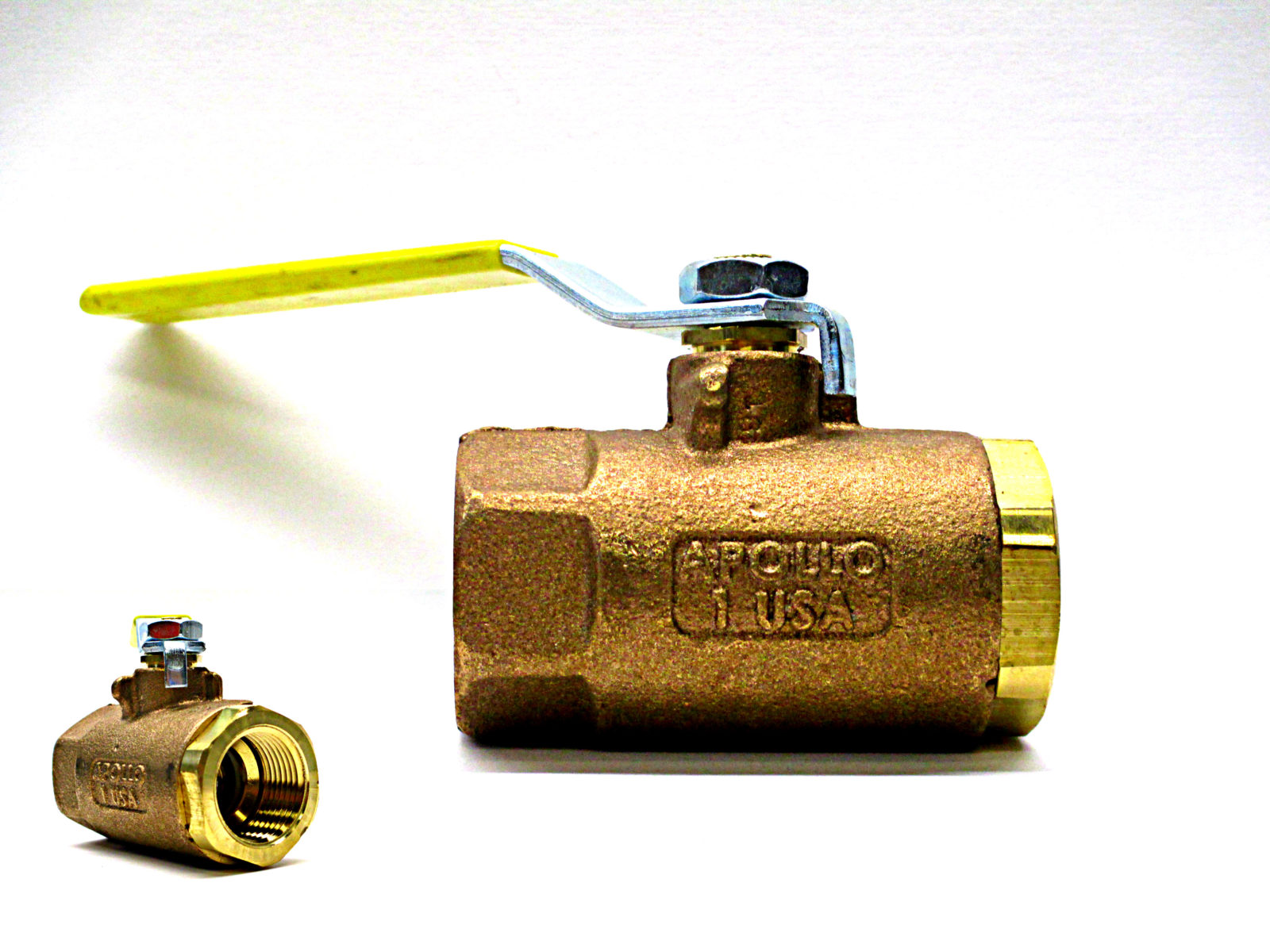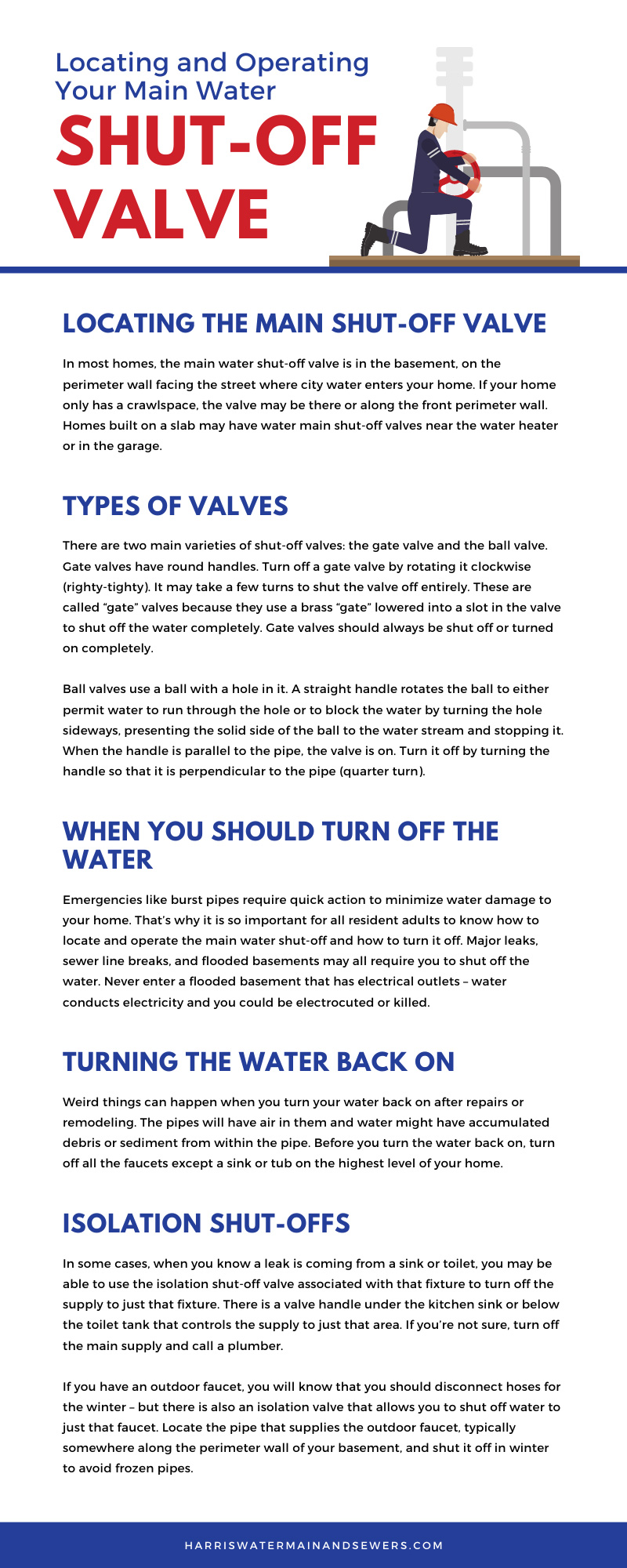All adults in your home should know about locating and operating your main water shut-off valve. This is critical in case of emergencies like burst pipes and leaks. Many plumbing repairs require that the water be shut off until the repair is complete. Sometimes, the city will shut off water to your home when making repairs to water mains in the street. Other times, your city may perform routine maintenance that affects your water supply like flushing fire hydrants.
Locating the Main Shut-off Valve
In most homes, the main water shut-off valve is in the basement, or outdoors around the perimeter wall facing the street where city water enters your home. If your home only has a crawlspace, the valve may be there or along the front perimeter wall. Homes built on a slab may have water main shut-off valves near the water heater or in the garage.
Types of Valves
There are two main varieties of shut-off valves: the gate valve and the ball valve. Gate valves have round handles. Turn off a gate valve by rotating it clockwise (righty-tighty). It may take a few turns to shut the valve off entirely. These are called “gate” valves because they use a brass “gate” lowered into a slot in the valve to shut off the water completely. Gate valves should always be shut off or turned on completely.
Ball valves use a ball with a hole in it. A straight handle rotates the ball to either permit water to run through the hole or to block the water by turning the hole sideways, presenting the solid side of the ball to the water stream and stopping it. When the handle is parallel to the pipe, the valve is on. Turn it off by turning the handle so that it is perpendicular to the pipe (quarter turn).
If the handle is difficult to turn, try putting on a pair of work gloves to give you a better grip. Never force a stuck valve; it could break and cause substantial damage with uncontrolled water flowing into your home. Call a licensed plumber for help.
Separate Valve for Fire Sprinkler System
Homes equipped with fire sprinkler systems will most likely have two shut-off valves: one for the fire sprinkler and another for the rest of the house. You should not turn off the fire sprinkler water supply unless advised by a licensed plumber, DEP, or city water department personnel. The fire sprinkler valve is also known as an OSY valve (outside screw & yoke) and functions by opening and closing with a gate that lowers in and out of the valve body itself. When the stem of the OS&Y is raised on the top of the valve, you know that the water is open and functioning. If the stem appears to be sunken in the body of the valve, it means that the gate is closed and no water can flow through.
When You Should Turn Off the Water
Emergencies like burst pipes require quick action to minimize water damage to your home. That’s why it is so important for all resident adults to know how to locate and operate the main water shut-off and how to turn it off. Major leaks, sewer line breaks, and flooded basements may all require you to shut off the water. Never enter a flooded basement that has electrical outlets – water conducts electricity and you could be electrocuted or killed. Call your electric utility for help and advice about shutting off the main electrical supply to your home before attempting to enter the basement.
If you’ll be away from your home for an extended amount of time, you should turn off your main water supply and drain your pipes. Once the water is off, turn on all the faucets until no water comes out, then turn them off. If your home uses a well, turn off the electric supply to the well pump to prevent it from pumping water into your pipes.
Turning the Water Back On
Weird things can happen when you turn your water back on after repairs or remodeling. The pipes will have air in them and water might have accumulated debris or sediment from within the pipe. Before you turn the water back on, turn off all the faucets except a sink or tub on the highest level of your home.
Turn on the main water valve slowly. Keep in mind that the water might be brown and rusty and that there may be noise and vibration or banging as air drains out of the pipe. When the water flows clear and steady out of the faucet, close it. Listen for any continuing noise to stop. Remove aerators from sink faucets to keep them from clogging with debris that shakes into the water when you turn the supply back on. Open those faucets to bleed air out of the pipes, then close them one at a time after the water runs clear.
Check the valve stem on the main water shut-off valve. If it leaks, gently tighten the valve stem nut, but don’t overtighten it.
Isolation Shut-offs
In some cases, when you know a leak is coming from a sink or toilet, you may be able to use the isolation shut-off valve associated with that fixture to turn off the supply to just that fixture. There is a valve handle under the kitchen sink or below the toilet tank that controls the supply to just that area. If you’re not sure, turn off the main supply and call a plumber.
If you have an outdoor faucet, you will know that you should disconnect hoses for the winter – but there is also an isolation valve that allows you to shut off water to just that faucet. Locate the pipe that supplies the outdoor faucet, typically somewhere along the perimeter wall of your basement, and shut it off in winter to avoid frozen pipes.
City Shut-Offs for Repairs or Maintenance
Many New Yorkers have experienced city water shut-offs when the city must respond to broken water mains, install city pipes, or run new mains to their city block. The city should inform you when they are going to be doing work on your block. When the water comes back on, you may experience some of the same noise, vibration, and rusty-looking water that happens when you first turn on the valve within your home after a shut-off.
Other Water Main Repairs
In New York City, homeowners are responsible for the water line that connects the city main to the house, even if the pipe runs beyond their property. If you try to turn off your water and it doesn’t stop flowing or loses pressure, especially if your water is discolored or contains sediment, contact a licensed plumber immediately. You may have a damaged water line running from the city supply to your home, and you should repair it as soon as possible. For water main repair in Brooklyn or throughout New York City, make sure you call a licensed, bonded professional plumbing company with experience complying with all city codes and DEP regulations.
If You Can’t Find Your Shut-Off Valve
Some older homes or homes in colder climates may have water shut-off valves outside the home near the water meter or buried in a concrete box with a removable lid. The boxes may contain a meter and two valves – the one closest to the home is the only valve you should ever touch. The one opposite the meter and closest to the street is the city shut-off, and you should never touch it. Call your city water department for help if you can’t open the box (some need a “meter key”) or if you aren’t sure which valve to try. If there is sand or dirt around the pipes, keep it, because it is there to insulate the pipes from freezing.






















